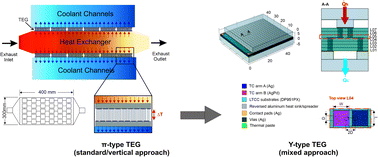LTCC-based Y-type thermoelectric generator with an improved heat flow guide for automotive waste heat recovery
Abstract
Thermoelectric generators (TEGs) are essential devices that convert thermal energy into electrical energy. TEGs are well known for their reliability, environmental friendliness, and maintenance-free operation. The fabricated low-temperature co-fired ceramic (LTCC)-based silver/silver–palladium Y-type thermoelectric generator is designed to convert a vertical distribution of heat flow into voltage through 333 laterally oriented thermocouples. It is intended to be placed between the heat exchanger and the coolant channels in the exhaust system to harvest waste thermal energy. The novel design helps to minimize the overall internal electrical resistance of the generator, which leads to higher generated electrical power. We investigated the use of aluminum-plates with pillars as heat guides combined with LTCC built-in cavities to minimize heat losses and improve the thermal yield. This technique allows increasing the electrical power by 67% compared to flat heat guides. The paper presents both simulations, based on the finite element method, and experimental measurements to validate the proposed model's accuracy. Experiments gave an output voltage of 87.3 mV and a delivered power of 260 μW (equivalent to 1.51 μW K−1) at ΔT = 172 °C for the generator TEG without cavities, while these results were 94.1 mV and 306.3 μW (equivalent to 1.78 μW K−1) at the same temperature difference when cavities were added.



 Please wait while we load your content...
Please wait while we load your content...